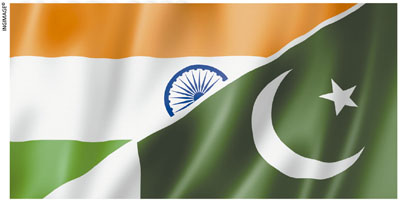THE ROVING DIPLOMAT
A POTENTIAL CATASTROPHE
When Indo-Pak tensions continued to stall the SAARC initiative
 South Asia has continued to be overshadowed by a dangerous buildup of tensions between India and Pakistan, which has the potential to lead to a catastrophic conflict. Neither side appears to want such a conflict but they are moving along a conflicting course that is seemingly out of control.
South Asia has continued to be overshadowed by a dangerous buildup of tensions between India and Pakistan, which has the potential to lead to a catastrophic conflict. Neither side appears to want such a conflict but they are moving along a conflicting course that is seemingly out of control.
The situation presents the culmination of tensions that originated with the nuclear test explosions that were followed by the Kargil operation and hijacking incident with each adding more fuel to the fire.
Remarkably, the parties avoided a wholesale conflagration as the Kargil operation was localised into a frontier conflict while the hijacking incident was settled amicably with minimal loss of life.
This reveals a state of brinkmanship like that of the Cold War with no deliberate confrontation in mind. Besides, there have been reassuring developments like the Lahore Declaration and amicable settlement of the Kargil operation, which indicates a basically peaceable disposition.
But it would seem as if the atmosphere has changed, judging by some developments – one of them being the hijacking incident. Though resolved amicably, it set off a war of words and allegations: India called Pakistan a terrorist state and the latter accused the former of conducting a slanderous campaign.
Such exchanges have been a feature of lndo-Pak relations but attitudes have betrayed a change on the part of India. This appears to revolve around the disapproval of the political change in the establishment of the military regime of General Pervez Musharraf; and while it did not associate itself with the suspension of Pakistan by the Commonwealth, it would seem that India has reservations about its neighbour’s non-democratic character.
In the meantime, there’s been a flurry of activity at the international level with both India and Pakistan embarking on bridge-building campaigns – the high-level talks between the US and Pakistan that almost coincided with similar discussions between Indian and American representatives, which intended to precede the visit of then-President Bill Clinton to India. The talks were on a broader canvas, and included both the US president’s visit and India’s nuclear ambitions.
But this meeting coincided with crucial negotiations between India’s then-Foreign Minister Jaswant Singh and US Deputy Secretary of State Strobe Talbott on the touchy subject of nuclear policies. In essence, it was a question of the US wanting India to sign the Comprehensive Test Ban Treaty in line with its concerns over non-proliferation and the latter’s insistence (based on its own security) on a minimum nuclear deterrent.
It was thought that Clinton’s visit would depend on the outcome of these talks, which explained the procession of US Senators and officials who visited India leading up to the talks in a determined effort to reconcile the two positions.
As Indo-US relations assumed a special importance in the Indo-Pak Cold War, both sides would have no doubt done their utmost to arrive at an understanding.
The visit of Musharraf in China at that precise moment was a kind of rejoinder to India’s initiatives with the US, and served to emphasise that Pakistan also had a patron to whom it can turn.
Ostensibly, the visit was intended – in the words of a Foreign Office spokesman – to reaffirm Pakistan’s close and cordial ties with China. It was to be an equally acid test for China’s diplomacy at a time when it’s in the process of mending fences with both India and the United States.
No doubt, a key issue was that of Kashmir. As in the past, China backed Pakistan’s claim to it and Musharraf issued an invitation to India to begin discussing the issue. Therefore, these international initiatives on all sides are an endeavour to defuse Indo-Pak tensions.
The overhanging question is still the future of SAARC. The situation is much like a case of Nero fiddling while Rome was burning. SAARC was formed for the express purpose of promoting fellowship, and defusing tensions through the good offices and goodwill of all concerned.
But the apparent deadlock over fixing a date for a summit suggests the absence of such a fraternal approach. Instead, the trend is towards internationalising interstate relations, as revealed by the rush of foreign initiatives to resolve the Indo-Pak crisis.
This seemed to detract from the objectives and ethos of SAARC, reverting to the times of axis diplomacy when the region was divided between the China-Pakistan and Indo-Soviet axes.



